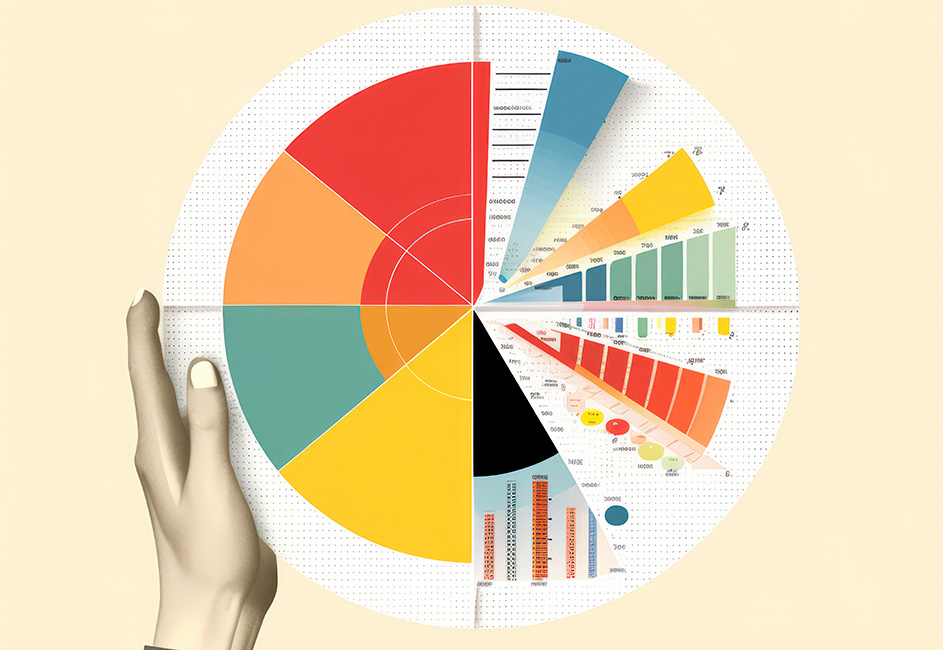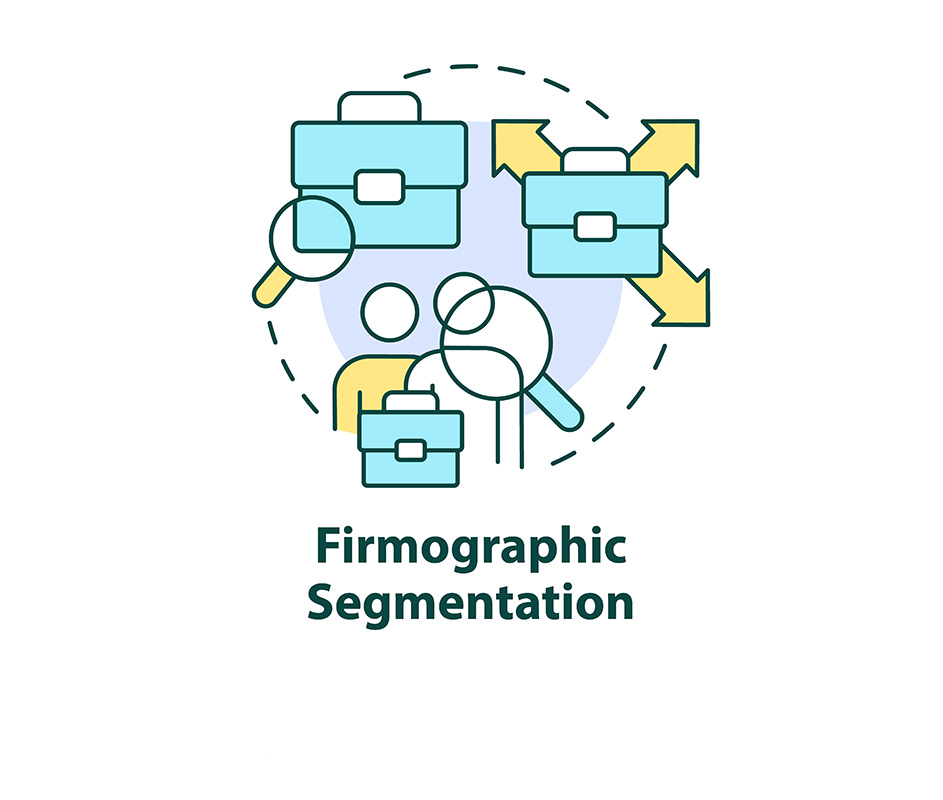
- Brief Overview of Market Segmentation
- Market Segmentation Vs. Customer Segmentation
- Market Segmentation in STP Approach
- Market Segmentation in B2C Settings
- Market Segmentation in B2B Settings
- Evolution of Market Segmentation
- Benefits of Market Segmentation
- Market Segmentation Strategies
- Challenges and Considerations in Market Segmentation
- Technologies and Trends Boosting Market Segmentation
- Insights from Top Brands
- Conclusion
You want your message to resonate with your potential customers, right? Communication is essential, but as your audience grows, their preferences and opinions broaden.
This expansion increases the risk of your message becoming lost or irrelevant. However, segmenting your target market is essential to ensure your message remains impactful and relevant to the majority of your audience.
This blog post explores market segmentation strategy, including its best practices, common challenges, and evolving trends. These are all aimed at helping you better understand your customer base for more effective communication.
Brief Overview of Market Segmentation
Market segmentation is a strategy aimed at dividing your market into smaller segments distinguished by specific traits for enhanced targeting and understanding.
By segmenting your market, you can direct your efforts to meet each group’s unique needs and preferences.
It’s like customizing your message for different audiences, making it more relevant and appealing. This enables you to craft targeted strategies that resonate with each segment. By customizing your strategies to resonate with the unique characteristics of each group, you increase the chances of success and magnify the impact of your strategies.
Market segmentation can be a game-changer in both B2C and B2B settings. It empowers you to focus your resources where they will have the greatest impact, driving growth and profitability for your business. Instead of attempting to target a broad audience, you can concentrate your resources where they’ll have the most impact.

Market Segmentation Vs. Customer Segmentation
It’s crucial to grasp the distinct focuses and objectives of market segmentation and customer segmentation in order to maximize the impact of marketing strategies. Customer segmentation revolves around analyzing your ‘current’ customer base and identifying particularly profitable customers.
This approach delves deep into the characteristics, behaviors, and interactions of individual customers who have already engaged with your brand. It involves scrutinizing demographics, geographics, psychographics, and behaviors to create nuanced personas that reflect different customer profiles.
By conducting data-driven analyses based on their purchasing behaviors and past engagements with your brand, you can use your marketing strategies and offerings to meet their needs and preferences better, ultimately driving higher customer satisfaction and loyalty.
In contrast, market segmentation takes a broader view, focusing on dividing the overall market into distinct segments based on various criteria beyond just your existing customer base.
While customer segmentation focuses on understanding and catering to the needs of individual customers, market segmentation considers the broader landscape of potential customers and competitors. It involves identifying different market groups with similar characteristics, preferences, and needs.
These segments may encompass demographic, geographic, psychographic, or behavioral factors, but the aim is to identify opportunities and tailor marketing strategies to reach and engage with these different segments effectively.
By understanding the nuances of market segmentation, you can refine your targeting resources, optimize resource allocation, and capitalize on opportunities for growth within your industry.
Market Segmentation in STP Approach
Market segmentation denotes both the overall process of dividing your market into distinct groups and also the first step of the S-T-P (Segmentation, Targeting, and Positioning) framework. STP approach redefines your target audience and communication strategy, making your marketing efforts more specific, relevant, and personalized to your customers.
Market segmentation helps you understand your audience better and sets the stage for effectively targeting and positioning your products or services.
When you engage in market segmentation, you’re essentially breaking down your market into smaller, more homogeneous segments based on various criteria. This process allows you to identify specific consumer groups with common characteristics and needs.
Once you have segmented your market, you can move on to the targeting phase of the S-T-P framework. Here, you select one or more segments on which to focus your marketing initiatives.

By targeting specific segments, you can modify your marketing messages, products, and promotions to resonate more effectively with the needs and preferences of those particular groups.
Furthermore, market segmentation lays the groundwork for positioning your brand or products in the minds of consumers. By understanding each segment’s unique characteristics and preferences, you can develop positioning strategies that highlight the distinct value propositions of your offerings. This aids in setting your brand apart from competitors and create a compelling brand image.
By incorporating market segmentation into the S-T-P framework, you can streamline your marketing and enhance the effectiveness of your overall strategy. As a result, you can optimize your marketing campaigns, boost customer satisfaction, and drive business growth.
Market Segmentation in B2C Settings
In B2C environments, understanding the diverse consumer market is essential. Businesses can adjust their marketing strategies effectively by segmenting this market into distinct groups. These segments are categorized based on various criteria, such as demographics, psychographics, and behavioral patterns.
Demographics
Demographics offer valuable insights into the characteristics of your target audience. You can tap into demographic data to understand the age, gender, income level, education, occupation, and other defining traits of your customers.
By segmenting your market based on demographics, you can tailor your marketing strategies to resonate effectively with different demographic profiles. For instance, if your product primarily targets young professionals, you might focus your advertising campaigns on platforms popular among that demographic, such as social media or digital channels.
Understanding the demographic makeup of your audience enables you to craft targeted messages and offers that speak directly to their needs and preferences. It ultimately drives higher engagement and conversion rates.

Geography
Geographic data can identify the specific locations where your potential customers reside or frequent. By segmenting your market based on geography, you can use your marketing campaigns to cater to the unique needs, cultural nuances, and preferences of different regions.
For instance, if your business operates in multiple locations, you can customize your advertising campaigns to reflect each area’s local interests and trends.
Understanding the geographical layout of your customer base allows you to allocate resources effectively, target your promotional activities strategically, and maximize your market penetration in each region.

Psychographics
Generally speaking, Psychographics is the science of using psychology and demographics to better understand consumers. Psychographic factors are significant in market segmentation, providing invaluable insights into the lifestyles, values, social class, personality characteristics, and motivations of your target audience. Understanding your customers’ psychographic makeup allows you to create more personalized and resonant marketing strategies.
By discovering the deeper aspects of consumer behavior and preferences, you can modify your messaging and offerings to align with the specific interests and aspirations of different psychographic segments.
For example, if your product appeals to environmentally conscious consumers, you can emphasize sustainability and eco-friendly features in your marketing materials to connect with this segment on a deeper level.
By tapping into psychographic factors, you can forge stronger emotional connections with your audience, improve brand loyalty, and drive meaningful engagement that transcends mere transactions.
Behaviors
Consumers aren’t homogenous entities; they have their understanding, feelings, and reactions to your products or services. By segmenting your market based on these multifaceted dimensions, you gain invaluable insights into the nuanced preferences and behaviors of different consumer groups.
You can pinpoint your loyal customers, identify potential high-value segments, and adjust your marketing strategies to resonate with each group more effectively. Understanding their usage and engagement rates, loyalty statuses, or readiness stages empowers you to craft targeted messages and offerings that speak directly to the specific needs and desires of each segment.
This approach helps to enhance customer satisfaction, drive engagement, and ultimately bolster your bottom line.
Beliefs and Values
Understanding beliefs and values helps you recognize how consumers’ religious affiliations, political inclinations, and nationalistic sentiments shape their purchasing behaviors. By discerning whether your target audience is deeply religious or politically active, you can improve your marketing strategies.
Whether they take pride in their nationality or are indifferent towards it, acknowledging these factors allows you to engage with consumers on a deeper level.
Crafting messages that resonate with their beliefs and values is crucial, as this fosters stronger emotional connections and increases brand loyalty.
Market Segmentation in B2B Settings
Market segmentation helps you identify and target the most promising opportunities within the broader market landscape. It’s not merely about categorizing your clients; it’s about understanding the intricate dynamics that shape their decision-making processes.
Therefore, as highlighted by experts such as Winer and Dhar (2010) and Kotler and Keller (2016), market segmentation in B2B contexts includes various elements, from details about companies to situational factors:
Firmographics
Firmographics are data attributes related to companies and organizations that can be used to categorize and segment these entities for targeted marketing and sales strategies.
Similar to how demographics provide details about individual people, firmographics include details about businesses, such as industry, location, size, status or structure, and performance.

For example, if you offer software solutions, you may find that businesses in certain industries or of a particular size have distinct needs or preferences that require tailored approaches. Understanding firmographics enables you to customize your offerings and marketing strategies to better align with each segment’s specific requirements, ultimately increasing your strategies’ relevance and effectiveness.
Operating Variables
Operating variables also offer insights into how clients interact with your products or services. Variables such as technology usage, user status, and customer lifetime value provide valuable data that can inform your segmentation strategy.
For instance, by analyzing the technology infrastructure of your clients, you can identify segments that are more likely to benefit from advanced features or integrations. Similarly, understanding user status and customer lifetime value allows you to prioritize segments with higher potential value and adjust your retention efforts accordingly.
Purchase Framework
The purchase framework illuminates the decision-making processes within client organizations. Factors such as power structure, business relationships, and purchase criteria influence how decisions are made and who holds the most sway in the buying process.
These dynamics help you identify key decision-makers and influencers within each segment and tailor your sales and marketing strategies to connect with them effectively.
For example, if you’re targeting segments with complex power structures, you may need to invest more resources in building relationships with multiple stakeholders and providing personalized solutions that address their particular demands and concerns.
Situational Factors
Situational factors, such as the types of applications for your products or services, the degree of purchase urgency, and the size of orders, offer insights into your clients’ immediate needs and priorities.
By understanding situational factors, you can tailor your sales and marketing initiatives to address these needs more effectively. For instance, if you offer a product with urgent applications, you may need to focus on segments where time-sensitive solutions are in high demand and position your offerings accordingly.
Personal Characteristics
Personal characteristics provide additional insights into the psychological and emotional aspects of client behavior, which can further refine your market segmentation strategy in B2B settings.
Factors such as loyalty to the supplier, buyer attitudes toward risk, and congruency of values offer valuable information that can help you tailor your sales and marketing to resonate with each segment’s specific preferences and motivations.
For example, if you identify segments with a high level of loyalty to their suppliers, you may need to focus on building trust and credibility to overcome barriers to entry. Similarly, if you identify segments with risk-averse buyers, you may need to emphasize the reliability and stability of your products or services in your messaging.
So, market segmentation is a powerful tool that allows you to laser-focus your marketing activities on the most receptive audience segments. By considering various factors in B2C and B2B settings, you can tailor your messaging and offerings to resonate with different customer groups.

Evolution of Market Segmentation
In 1978, Arnold Mitchell and colleagues introduced the Values and Lifestyles (VALS) program, utilizing insights from sociologist David Riesman and psychologist Abraham Maslow. VALS is a research methodology used for psychographic market segmentation. It categorized individuals into nine psychological types, influencing consumer behavior understanding.
However, despite its popularity, segmentation strategies, like VALS, have limitations in predicting purchasing behavior and informing market decisions. While still widely used, market segmentation’s effectiveness remains questionable.
According to Harvard Business Review, in 2004, 59% of senior executives conducted major segmentation exercises, but only 14% found them valuable.
Recognizing that people are more than just statistics, marketers delved deeper into understanding the underlying motivations and preferences that drive individual choices.
In 2017, marketing 4.0 emerged as a response to the digital revolution sweeping across industries. It marked the start of an era where technology became the cornerstone of marketing strategies, enabling brands to create unparalleled connections with consumers.
In this digital landscape, social media platforms have been essential engagement spaces, data analytics has become the compass guiding marketing decisions, and artificial intelligence is now the engine driving personalized experiences.
Technology is now vital in market segmentation, enabling marketers to analyze enormous volumes of data to reveal valuable insights. Through sophisticated algorithms, they can identify patterns, trends, and correlations within the data, painting a richer portrait of consumer behavior.

The concept of “segments of one” epitomizes the pinnacle of personalized marketing. It transcends the limitations of traditional segmentation by treating each customer as a distinctive entity with special preferences, needs, and behaviors.
By tapping into data analytics and machine learning, marketers can craft customized experiences that resonate with individual consumers on a profound level.
Individual marketing is about understanding their aspirations, addressing their pain points, and anticipating their desires. In doing so, brands can develop loyalty, drive advocacy, and ultimately cultivate long-term relationships with their audience.
After all, the evolution of market segmentation from traditional methods to individual marketing epitomizes the symbiotic relationship between technology and consumer engagement. In the Marketing 4.0 era, technology serves as both the catalyst and the conduit for deeper connections between brands and consumers, reshaping the marketing landscape in profound ways.
Benefits of Market Segmentation
By segmenting your market, you can effectively target your resources and efforts, optimizing your chances of success in an increasingly competitive business landscape. Market segmentation empowers you to navigate the complexities of the market, identify lucrative opportunities, and position your business for sustainable growth and profitability.
Meeting Specific Target Market Needs
Market segmentation is crucial for effectively meeting the needs of particular target market segments. Not all customers are the same; they have distinct preferences, behaviors, and expectations. By segmenting your market, you can identify these differences and customize your products or services to address the specific needs of each segment.
For example, if you operate in the fashion industry, you may have segments such as trend-conscious millennials, budget-conscious families, and luxury-seeking professionals. Each segment has unique requirements and desires, and by understanding these nuances, you can develop products, pricing strategies, and marketing campaigns that cater to their preferences.
This customized approach increases the chances of customer satisfaction, loyalty, and repeat business, as you’re providing solutions that directly align with what each segment values most.

However, AI can pinpoint unique customer behaviors, habits, interests, and preferences, effectively allowing you to customize campaigns to specific segments. This ensures your messages resonate with your audience, driving engagement, loyalty, and business growth.
Meeting the needs of particular target market segments enhances customer experience, strengthens competitive advantage, and drives sustainable growth for your business.
Customizing Marketing and Selling Strategies to Each Segment
Market segmentation allows you to delve deeper into the various needs, preferences, and behaviors of your target audience. By segmenting your market, you gain insights into the specific characteristics of each segment, enabling you to modify your marketing and selling strategies accordingly.
For example, you may discover that one segment responds best to email marketing campaigns, while another prefers in-person sales presentations. By customizing your approaches to resonate with each segment’s unique preferences, you can maximize the effectiveness of your marketing and selling strategies.
This approach increases the probability of converting leads into customers and enhances customer satisfaction and loyalty. By finding the most effective strategies for each segment, you can optimize your resources and drive better results for your business.
Identifying High-Value Segments
Through market segmentation, you gain a detailed understanding of the different segments within your target market. This insight allows you to assess the profitability of each segment by analyzing factors such as revenue generated, costs incurred, and potential for growth.
By identifying high-value segments that yield the greatest returns on investment, you can focus your resources and campaigns where they will have the most significant impact. You can also identify segments that may be less profitable or require additional investment to reach their full potential.
This enables you to make informed decisions about resource allocation, pricing strategies, and product development initiatives. Through determining profitability, you can optimize your business operations and drive sustainable growth and success.
Optimizing Advertising and Marketing Budgets
Market segmentation is pivotal in helping you decide on advertising and marketing budgets with precision and effectiveness. You gain insights into different characteristics and preferences by segmenting your market.
This allows you to allocate your advertising and marketing budgets more strategically, directing resources where they will have the greatest impact. For example, you may find that certain segments are more responsive to digital advertising while others prefer traditional media channels.
By tailoring your modifying strategies to each segment’s preferences, you can maximize the reach and engagement of your campaigns while minimizing unnecessary expenses.
Additionally, market segmentation enables you to identify high-value segments with potential for ROI enhancement. By allocating more resources to these segments, you can capitalize on opportunities for growth and profitability, driving better results for your business overall.
Therefore, you can optimize your spending and succeed in reaching and resonating with your target market.
Determining Optimal Advertising Channels
Market segmentation empowers you to determine the media platforms in your marketing and advertising plans with precision and effectiveness. By segmenting your market, you gain insights into the preferences and behaviors of different segments, enabling you to identify the most suitable channels and platforms for reaching each audience.
This approach allows you to allocate resources strategically, optimizing your media mix to maximize the impact of your advertising and marketing. It also enables you to tailor your media plans to align with the habits and preferences of each segment, ultimately driving higher engagement and conversion levels.
Enhancing Emotional Connections
Market segmentation is pivotal for fostering emotional connections with your audience. By dividing your market into distinct segments, you gain valuable insights into the varied needs, preferences, and values of different customer groups.
This knowledge allows you to craft personalized marketing messages and experiences that resonate deeply with each segment, tapping into their emotions and aspirations. For instance, understanding that one segment prioritizes sustainability while another seeks convenience enables you to modify your messaging accordingly, enhancing a stronger emotional bond.
By connecting with customers on a more personal level, you enhance their loyalty and advocacy and create lasting relationships that drive sustained success for your business.
Developing Personalization
Market segmentation enables you to divide your audience into separate groups based on various factors such as demographics, behavior, or preferences. With AI, you can take personalization to the next level.
By analyzing extensive datasets, you can identify unique characteristics within each segment of your audience. AI algorithms enable you to discern patterns and preferences, allowing you to adjust your marketing tactics precisely.
You can deliver customized messages, product recommendations, and offers that resonate with each segment’s needs and interests. This level of personalization fosters stronger connections with your audience, driving higher engagement and loyalty.
Moreover, AI continuously learns from customer interactions, enabling you to refine and optimize your segmentation strategies over time. By harnessing AI for market segmentation, you can unlock the full potential of personalization, creating compelling experiences that drive business growth and success.
Driving Conversions
Market segmentation is also key to boosting conversion rates. You can target specific segments based on demographics, behavior, or preferences. You increase relevance and engagement by directing your marketing projects towards these segments.
This generates higher conversion rates as your messages resonate more effectively with your audience. Additionally, segmentation allows you to identify high-value segments and prioritize resources accordingly.
You can maximize conversion rates and drive business growth by focusing on the most profitable segments. Furthermore, segmentation enables you to personalize your offers and promotions, further increasing conversion rates by appealing directly to individual customer needs and preferences.
Through segmentation, you understand your target market comprehensively, enabling you to identify specific customer groups with unique needs, preferences, and behaviors. This knowledge empowers you to customize your products, services, marketing strategies, and customer experiences to effectively meet the diverse demands of each segment.
However, to fully capitalize on market segmentation, you need well-defined strategies aligning with each segment’s characteristics and your overall business objectives.
Market Segmentation Strategies
Market segmentation strategies equip you to reach and engage your target audience effectively. By mastering best practices, you empower yourself to distinguish the needs, preferences, and behaviors of different market segments.
Here, we’ll explore top market segmentation strategies to elevate your business and enhance stronger connections with your audience.
Define the Broader Market Landscape
First, you need to identify the broad scope of potential customers for your business. This involves understanding the general characteristics and demographics of the audience you aim to reach.
By delineating your market, you can allocate resources wisely. You need to know who you’re targeting and why they might be interested in your products or services.
This segmentation strategy helps you customize your marketing messages and product offerings to specific groups within your market. It allows you to identify niche opportunities and develop strategies to capitalize on them.
By defining your overall market, you can better position your business for success and establish a clear direction for growth. Understanding the diversity within your market enables you to adapt your approach and stay relevant in a competitive landscape.
Set Clear Market Segmentation Objectives
As the second step, you must outline your goals for dividing your target market into distinct segments. You need to define what you aim to achieve through segmentation, whether it’s to better understand your customers, improve targeting precision, or increase sales effectiveness.
You can align your projects with your broader business goals by clarifying your segmentation objectives. Identifying specific criteria for segmenting your market helps you pinpoint the most relevant and actionable segmentation variables for your business.
Your objectives should be measurable and realistic, allowing you to track progress and adjust strategies. You should also consider the potential impact of segmentation on various aspects of your business, such as marketing effectiveness, product development, and customer satisfaction.
Choose the Right Market Segmentation Variables
You need to identify the key factors that differentiate your customers, such as demographics, psychographics, behavior, or geographic location. By defining these variables, you can alter your marketing initiatives to better meet the unique needs and preferences of each segment.
This allows you to create more targeted and relevant messages, products, and promotions. It would help to consider which variables will provide the most valuable insights into your customers’ buying preferences and motivations.
By selecting the right segmentation variables, you can enhance your understanding of your customers and improve the overall effectiveness of your marketing strategies.
Ensure Viability of Every Segment
By evaluating aspects such as size, growth potential, purchasing power, and accessibility, you can determine if a segment is worth pursuing or is too small or niche to justify investment.
You must also analyze the competitive landscape within each segment to understand your position and opportunities. This involves researching competitors’ strengths, weaknesses, and market share to identify areas where you can differentiate and compete effectively.
Additionally, you should evaluate the feasibility of reaching and serving each segment efficiently. This includes assessing distribution channels, logistical considerations, and operational capabilities. By ensuring each segment is viable, you can target the most promising opportunities and maximize your chances of success in the market.
Consider Dynamic Segmentation
Embracing dynamic segmentation can revolutionize your market segmentation strategy. It is necessary to recognize that consumer preferences constantly evolve, making static segmentation approaches insufficient.
With dynamic segmentation, you adapt to these changes in real time, ensuring your marketing strategies remain relevant and effective. Data analytics and customer insights help refine your segmentation criteria and continuously identify emerging trends.
By staying agile and responsive, you can anticipate shifts in market segments and adjust your strategies accordingly. This allows you to seize new opportunities and mitigate risks more effectively.
Additionally, dynamic segmentation enables you to personalize your marketing messages and offerings at scale, enhancing customer engagement and loyalty. By adopting a dynamic approach to segmentation, you can set yourself apart in the competition and drive sustained growth for your business.
Utilize Multiple Data Sources
Multiple data sources help you gain a comprehensive understanding of your target audience. You can utilize various sources, such as surveys, social media metrics, and customer feedback, to gather rich insights into target market segments.
By analyzing data from diverse channels, you gain a more holistic view of your audience, enabling you to create more accurate and effective segmentation criteria.
Additionally, by tapping into multiple data sources, you can reveal hidden patterns and evolving trends that may not be apparent from a single source alone. This comprehensive approach to market segmentation empowers you to make educated choices and accelerate business growth effectively.
Leverage AI-Powered Engagement
Employing AI-driven analytics enables you to identify patterns and trends in consumer attitudes. By leveraging AI algorithms, you can segment your target your audience more accurately and efficiently than ever before.
AI has also revolutionized technographic segmentation, transforming how businesses understand and engage with their customers’ technological preferences. Technographic segmentation involves analyzing the technology usage and preferences of target consumers.
It goes beyond traditional demographics to consider factors such as software preferences, device usage, and online interactions. This approach gives businesses valuable insights into their customers’ digital habits, enabling more targeted and effective marketing strategies.
Moreover, AI equips you to examine data from multiple channels, including social media, email, website interactions, and offline engagements. You can gain insights into customer preferences across these channels, allowing you to create a unified view of each segment.
With AI, you can conduct real-time data analysis, providing immediate insights into customer behavior and preferences. This allows you to adapt your segmentation approach dynamically, ensuring relevance and effectiveness.
Moreover, AI enables you to handle large data sets efficiently, processing vast amounts of information quickly and accurately. This means you can segment your target audience more comprehensively, uncovering nuanced patterns and trends that might otherwise go unnoticed.
Craft Segment Profiles
By creating these profiles, you can better understand your customers and adjust your strategies accordingly. For each segment, you should include information such as age, gender, income level, lifestyle choices, and buying motivations.
This helps you identify unique needs and preferences within each group and craft targeted messages that resonate with them. Additionally, you can use these profiles to personalize your products, services, and promotions to meet the specific needs of each segment.
By creating accurate and comprehensive profiles for your segments, you can effectively connect with your target audience and drive business growth.
Continuously Review and Update Market Segmentation Strategy
Continuously reviewing and updating your market segmentation strategy helps to ensure it remains relevant and aligned with changing consumer choices. By regularly assessing the effectiveness of your segmentation approach, you can identify any shifts in consumer preferences or market dynamics.
Don’t forget to conduct pilot campaigns or small-scale tests to assess the impact and viability of your segmentation strategy before full-scale implementation. This approach allows you to fine-tune your segmentation criteria and messaging based on real-world results, increasing the likelihood of success when implementing larger-scale initiatives.
Updating your segmentation strategy enables you to outpace competitors and capitalize on emerging trends or opportunities in the market. By remaining flexible and responsive, you can maintain a competitive advantage and drive sustained growth for your business.
Furthermore, it helps to understand the challenges and obstacles and provides valuable insights for refining your segmentation strategy. This knowledge enables you to address specific pain points and needs within different market segments.
Challenges and Considerations in Market Segmentation
Challenges in the process of market segmentation can significantly impact your strategies and outcomes. Therefore, you must tackle these obstacles to ensure the effectiveness of your segmentation efforts.
Below, you’ll discover an overview of the challenges and considerations in market segmentation.
Overgeneralization
It’s a common pitfall to assume homogeneity within segments. Overlooking the nuances and diversity within each segment can undermine the effectiveness of your targeting efforts. By failing to understand your audience’s intricacies, you risk missing out on valuable opportunities.
To overcome this challenge, it’s imperative to conduct thorough research and analysis and explore various needs and preferences of your target segments. This will ensure resonance and engagement with your audience.
Changing Consumer Preferences
Consumer preferences are not static; they fluctuate based on trends, technological advancements, and shifts in societal norms. Your ability to adapt to these changes is paramount. Failing to do so could mean losing touch with your customer base and falling behind your competitors.
It’s imperative to stay vigilant and proactive in monitoring market shifts. By doing so, you can ensure that your segmentation strategies remain effective and aligned with the evolving demands and desires of your target market.
Embracing flexibility and agility in your approach to market segmentation will enable you to maintain relevance and competitiveness in an ever-evolving business landscape.
Cost and Time Constraints
Market segmentation demands significant resources, including time and money. However, tight budgets and busy schedules can pose challenges. These constraints might limit the depth of your segmentation analysis.
Therefore, it’s crucial to find a balance between thorough segmentation and practical constraints. This means optimizing your resources wisely to ensure that your segmentation efforts are effective and feasible within the scope of your business operations.
By carefully managing costs and time, you can maximize the impact of your segmentation strategies by spending your resources wisely.
Ethical Considerations
Neglecting ethical concerns can have serious repercussions. Practices like intrusive data collection or targeting vulnerable segments can tarnish your reputation and expose you to legal risks.
Therefore, you must uphold principles of transparency, fairness, and respect for consumer privacy throughout your segmentation efforts. By prioritizing ethical practices, you can build customer trust and safeguard your business against potential backlash.
Remember, maintaining integrity in your segmentation strategies is a moral obligation and a critical aspect of long-term success in today’s business landscape.
Data Availability and Quality
Accessing reliable and comprehensive data is essential for effective market segmentation. However, data availability and quality may present challenges.
Incomplete or outdated information can impede your ability to divide your market accurately, making it crucial to invest in extensive data collection and analysis methods. To overcome these challenges, you must utilize various techniques and tools to gather data from multiple channels, including customer surveys, market research reports, and social media analytics.
Remember to maintain the quality of your data by verifying its accuracy and relevance, regularly updating datasets, and staying attuned to market changes. Moreover, advanced analytical tools such as machine learning algorithms and predictive analytics help uncover hidden patterns and refine targeting strategies.
By prioritizing data quality and employing effective data collection and analysis methods, you can ensure that your segmentation efforts yield actionable insights that drive business growth and success.
Technologies and Trends Boosting Market Segmentation
The integration of AI-powered technologies has transformed the landscape of market segmentation. Internet of Things (IoT), Machine Learning, and Deep Learning algorithms empower you to analyze vast datasets quickly and accurately.
These technologies enable you to identify complex patterns and correlations within your target market, allowing for more precise segmentation and targeting:
IoT and Connected Devices
Innovations in IoT can revolutionize how you understand and engage with your target audience. IoT technology gathers vast amounts of data from various sources, providing valuable insights into consumer inclinations and preferences.
By using AI algorithms to process this data, you can uncover hidden patterns and correlations, enabling more precise segmentation. This enables you to develop strategies based on specific consumer segments, increasing the effectiveness of your campaigns.

Moreover, IoT enables real-time tracking and monitoring of consumer interactions, allowing you to adapt your segmentation strategies dynamically.
Machine Learning
Machine learning algorithms can analyze massive data collections to identify patterns and trends in customer choices. These algorithms can be used to process diverse data sources such as demographics, purchasing history, and online interactions.
This enables you to create detailed customer profiles and segment your audience according to their unique characteristics. By employing machine learning, you can automate the segmentation process, saving time and resources while improving the effectiveness of your marketing strategies.

Additionally, machine learning algorithms continuously learn and adapt, allowing you to refine your segmentation approach over time and stay ahead of changing market dynamics.
Embracing machine learning empowers you to unlock deeper insights into your customer base and drive targeted engagement strategies for maximum impact and growth.
Deep Learning
With its neural networks, deep learning enables you to identify intricate relationships within your data. By leveraging neural networks, you can process vast amounts of information and extract meaningful insights about your customers’ habits and preferences.
These sophisticated algorithms recognize complex patterns and nuances in data, allowing you to create highly accurate and detailed market segments. With deep learning, you can uncover hidden connections between different variables and uncover valuable insights that traditional segmentation methods might miss.

This advanced technology empowers you to refine your segmentation strategy continuously, adapting to changing market dynamics and customer preferences. By incorporating deep learning into your AI-powered segmentation approach, you can unlock new opportunities for targeted marketing and personalized customer experiences, driving growth and success for your business.
The integration of AI-powered technologies has undeniably revolutionized the landscape of market segmentation. By embracing these advanced technologies, you can unlock new opportunities for personalized marketing and drive growth and success in today’s competitive market landscape.
Insights from Top Brands
Market segmentation examples offer invaluable insights into how brands identify their audience’s needs and preferences. Examining successful segmentation practices can inspire and guide you in refining your approach to reaching and engaging with your target market.
Wells Fargo (WFC)
Through a strategic approach to catering to diverse market segments, Wells Fargo has established itself as a leader in the industry. The bank’s commitment to understanding the unique needs and preferences of various customer groups is evident in its expansive range of financial products and services.
From personalized personal banking solutions to specialized small business services and comprehensive wealth management offerings, Wells Fargo demonstrates a keen understanding of segmentation principles. With a keen eye on diverse customer needs, it offers an various financial services across the U.S. and worldwide.
JP Morgan Chase (JPM)
JP Morgan Chase (JPM) operates in over 100 countries, showcasing its global reach and influence. Renowned for its comprehensive consumer banking, investment services, and commercial banking offerings, JP Morgan Chase understands various market segments.
The bank’s leadership during economic growth and instability further underscores the effectiveness of its market segmentation strategy. This strategy allows JP Morgan Chase to modify its solutions based on the distinct needs and preferences of each segment, ensuring relevance and resonance.
Volkswagen
Volkswagen’s diverse automotive portfolio, including brands like Audi, Lamborghini, Porsche, and Ducati, showcases the power of market segmentation across multiple product lines and global markets.
Volkswagen maintains a robust presence in the global automotive industry by catering to distinct market segments with specialized vehicles and targeted marketing strategies. Each brand is designed for specific demographics, from luxury cars to high-performance vehicles.
This approach not only demonstrates Volkswagen’s understanding of diverse consumer needs but also serves as a valuable example for business owners seeking to implement effective segmentation strategies in their respective industries.
Coca-Cola
Coca-Cola’s extensive product line serves as another compelling example of market segmentation on a global scale. With a wide range of beverages for various tastes, preferences, and cultural contexts, Coca-Cola effectively reaches consumers across diverse demographics and geographic regions.
From classic sodas to healthier alternatives and regional variations, Coca-Cola demonstrates the power of segmentation in driving product innovation and market expansion.
Coca-Cola’s innovative segmentation strategies also reflect its commitment to meeting the ever-evolving needs of consumers worldwide, solidifying its position as a global leader in the beverage industry.
Victoria’s Secret
Victoria’s Secret showcases the effectiveness of market segmentation in the retail industry, particularly within the fashion and beauty sector. While the main brand primarily targets women with its lingerie and beauty products, Victoria’s Secret’s sub-brand, PINK, aligns with teenage girls and young women.
This segmentation allows Victoria’s Secret to effectively engage with different demographic groups, maximizing its appeal and market reach. It further demonstrates the power of segmentation in achieving competitive advantage.
Conclusion
Accurate market segmentation is crucial for businesses aiming for success. It enables you to understand your target markets, especially via AI-powered technologies like IoT, Deep Learning, and Machine Learning.
But segmentation doesn’t end there; it’s an ongoing journey that requires collaboration between segmentation teams and other departments within your organization. Team members should work together to modify and adapt strategies based on market insights and changing consumer tendencies.
All outcomes should be tested with the marketing team to reach clarity, ensuring that each strategy is tested and refined for optimal effectiveness.
At Dream Farm Agency, we recognize the significance of collaboration in achieving successful market segmentation. Our comprehensive branding and marketing services, from innovative tech solutions to creative content, are designed to support your business goals.
Contact us for more information, or leave a comment below if you have any queries or need assistance.

Fareena



